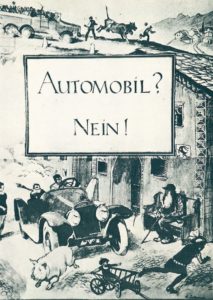Graubünden Car Free 1900-1925
5 March 2021
There were 136 passenger cars in 1925, 24 000 in 1967, and around 115 000 cars for 200 000 inhabitants in the canton of Graubünden in 2020.
The small number of cars in 1925 was due to the ban on vehicles from 1900 to 1925. Motorised traffic, ‘monster luxurius‘ or the ‘dubius vehicels‘ was strictly forbidden. The tourists either came by train or had to leave their cars at the cantonal borders and continue by horse-drawn carriage. It even happened that horses pulled the vehicle.
It was not conducive to tourism and economic development. Emotions ran high in the ten referendums between 1900 and 1925. The opponents saw the motor car as a threat to road safety, traditional horse-drawn carriage, horse trade, freight transport by pack animals, and a competitor to the railways. Proponents mainly saw economic benefits.
The opponents prevailed in five referendums up to 1918. Between 1918 and 1925, five more referendums followed. On 13 March 1921, the use of cars was allowed for medical reasons, fire brigades or certain other professions.
Finally, on 21 June 1925, most voters allowed motorised traffic, cars, motorbikes, and lorries. Environmental considerations, road safety or limiting transit traffic played no role whatsoever. A hundred years later, the reduction of transit traffic and the use of cars are again in the spotlight.

